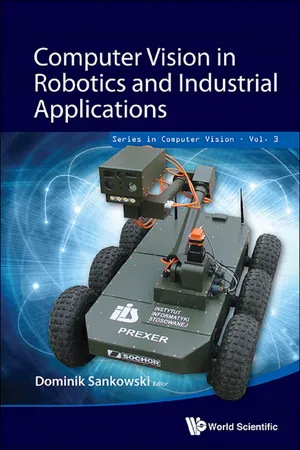
Computer Vision In Robotics And Industrial Applications
- 580 pages
- English
- ePUB (mobile friendly)
- Available on iOS & Android
Computer Vision In Robotics And Industrial Applications
About This Book
The book presents a collection of practical applications of image processing and analysis. Different vision systems are more often used among others in the automotive industry, pharmacy, military and police equipment, automated production and measurement systems. In each of these fields of technology, digital image processing and analysis module is a critical part of the process of building this type of system.
The majority of books in the market deal with theoretical issues. However, this unique publication specially highlights industrial applications, especially industrial measurement applications. Along with its wide spectrum of image processing and analysis applications, this book is an interesting reference for both students and professionals.
Contents:
- Theoretical Introduction to Image Reconstruction and Processing:
- Data Set Preparation for k -NN Classifier Using the Measure of Representativeness (Marcin Raniszewski)
- Segmentation Methods in the Selected Industrial Computer Vision Application (Anna Fabijanska and Dominik Sankowski)
- Line Fractional-Order Difference/Sum, Its Properties and an Application in Image Processing (Piotr Ostalczyk)
- Computer Vision in Robotics:
- Management Software for Distributed Mobile Robot System (Maciej Łaski, Sylwester Błaszczyk, Piotr Duch, Rafał Jachowicz, Adam Wulkiewicz, Dominik Sankowski and Piotr Ostalczyk)
- Advanced Vision Systems in Detection and Analysis of Characteristic Features of Objects (Adam Wulkiewicz, Rafał Jachowicz, Sylwester Błaszczyk, Piotr Duch, Maciej Łaski, Dominik Sankowski and Piotr Ostalczyk)
- Pattern Recognition Algorithms for the Navigation of Mobile Platform (Rafał Jachowicz, Sylwester Błaszczyk, Piotr Duch, Maciej Łaski, Adam Wulkiewicz, Dominik Sankowski and Piotr Ostalczyk)
- Partial Fractional-Order Difference in the Edge Detection (Piotr Duch, Rafał Jachowicz, Sylwester Błaszczyk, Maciej Łaski, Adam Wulkiewicz, Piotr Ostalczyk and Dominik Sankowski)
- Application of Fractional-Order Derivative for Edge Detection in Mobile Robot System (Sylwester Błaszczyk, Rafał Jachowicz, Piotr Duch, Maciej Łaski, Adam Wulkiewicz, Piotr Ostalczyk and Dominik Sankowski)
- Vision Based Human-Machine Interfaces: Visem Recognition (Krzysztof Ślot, Agnieszka Owczarek and Maria Janczyk)
- Industrial Applications of Computer Vision in Process Tomography, Material Science and Temperature Control:
- Hybrid Boundary Element Method Applied for Diffusion Tomography Problems (Jan Sikora, Maciej Pańczyk and Paweł Wieleba)
- Two-phase Gas-Liquid Flow Structures and Phase Distribution Determination Based on 3D Electrical Capacitance Tomography Visualization (Robert Banasiak, Radosław Wajman, Tomasz Jaworski, Paweł Fiderek, Jacek Nowakowski and Henryk Fidos)
- Tomographic Visualization of Dynamic Industrial Solid Transporting and Storage Systems (Zbigniew Chaniecki, Krzysztof Grudzień and Andrzej Romanowski)
- Tomography Data Processing for Multiphase Industrial Process Monitoring (Krzysztof Grudzień, Zbigniew Chaniecki, Andrzej Romanowski, Jacek Nowakowski and Dominik Sankowski)
- Dedicated 3D Image Processing Methods for the Analysis of X-Ray Tomography Data: Case Study of Materials Science (Laurent Babout and Marcin Janaszewski)
- Selected Algorithms of Quantitative Image Analysis for Measurements of Properties Characterizing Interfacial Interactions at High Temperatures (Krzysztof Strzecha, Anna Fabijańska, Tomasz Koszmider and Dominik Sankowski)
- Theoretical Introduction to Image Reconstruction for Capacitance Process Tomography (Radosław Wajman, Krzysztof Grudzien, Robert Banasiak, Andrzej Romanowski, Zbigniew Chaniecki and Dominik Sankowski)
- Infra-Red Thermovision in Surface Temperature Control System (Jacek Kucharski, Tomasz Jaworski, Andrzej Frączyk and Piotr Urbanek)
- Medical and Other Applications of Computer Vision:
- The Computer Evaluation of Surface Color Changes in Cultivated Plants Influence by Different Environmental Factors (Joanna Sekulska-Nalewajko and Jarosław Gocławski)
- Various Approaches to Processing and Analysis of Images Obtained from Immunoenzymatic Visualization of Secretory Activity with ELISPOT Method (Wojciech Bieniecki and Szymon Grabowski)
- Image Processing and Analysis Algorithms for Assessment and Diagnosis of Brain Diseases (Anna Fabijanska and Tomasz Węglinski)
- Computer Systems for Studying Dynamic Properties of Materials at High Temperatures (Marcin Bąkała, Rafał Wojciechowski and Dominik Sankowski)
Readership: Researchers, professionals and academics in image analysis, machine perception/computer vision, software engineering and fuzzy logic.
Frequently asked questions
Information
CHAPTER 1
DATA SET PREPARATION FOR K-NN CLASSIFIER USING THE MEASURE OF REPRESENTATIVENESS
Lodz University of Technology
90-924 Łódź, ul. Stefanowskiego 18/22
[email protected]
1.1 Introduction
1.2 Well-known reduction techniques
Table of contents
- Cover Page
- Title Page
- Copyright Page
- Contents
- Preface
- Part 1 Theoretical Introduction to Image Reconstruction and Processing
- Part 2 Computer Vision in Robotics
- Part 3 Industrial Applications of Computer Vision in Process Tomography, Material Science and Temperature Control
- Part 4 Medical and Other Applications of Computer Vision
- Index